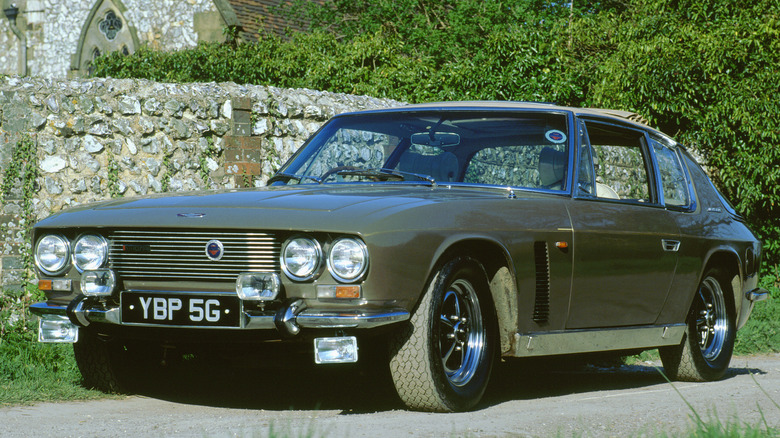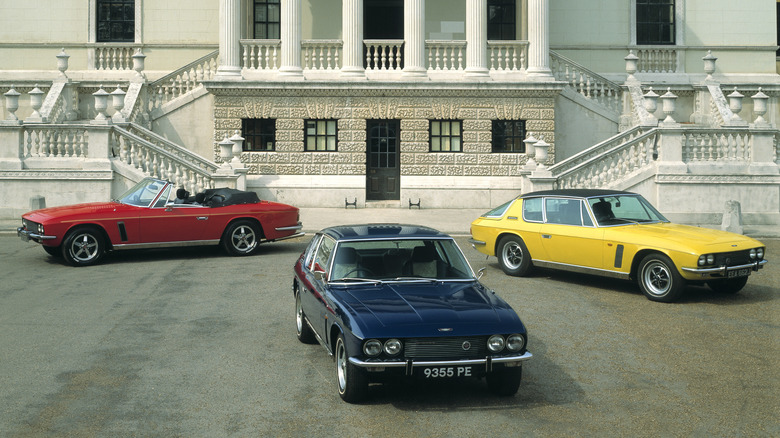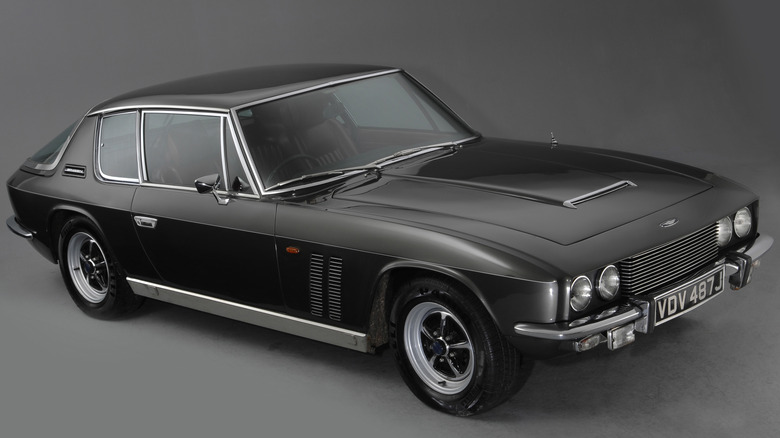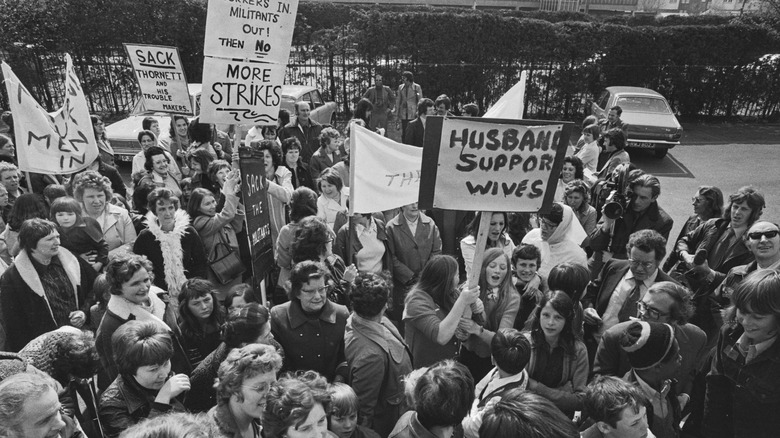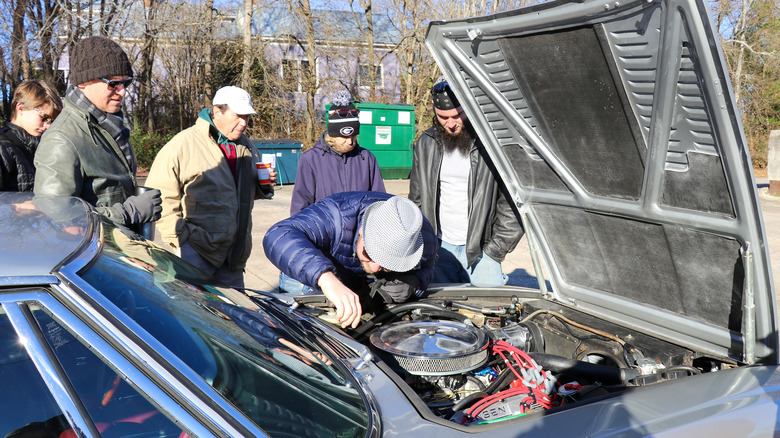Everything Classic Car Fans Should Know About Jensen Motors
When strolling through the cemetery that is the British motor industry, you may see the word Jensen chiseled into one of the bigger and fancier headstones. It's a company that was founded by a pair of brothers back in 1934 and went on to break records, pioneer auto tech, and establish something resembling a muscle car in Great Britain. Unfortunately, it met its end in the early '80s, and despite several revival attempts, doesn't seem to be coming back any time soon. Still, it left a pretty impressive legacy and still retains a special place in the hearts of many enthusiasts.
The company had a few famous fans, including Mick Fleetwood of Fleetwood Mac fame who has a Jensen C-V8 Mk II amongst the other highly desirable cars in his collection. Other famous Jensen owners include singer Cliff Richard, golfer Jack Nicklaus, and Henry Cooper — a boxer famous for flooring a young Muhammad Ali with a left hook. With that said, there's more to Jensen than a few famous faces.
It is best known for its muscle cars
While Jensen was founded long before the muscle car era, and the best of said era happened to be built in a different part of the world, the manufacturer seems to be closely associated with one style of vehicle. If you ask someone with an interest in classic cars to name something Jensen produced, it's almost certain they'll mention the Interceptor first. The Interceptor was first produced between 1950 and 1957, but the vehicles assembled in this first run have little in common with the iconic car Jenson put together in the '60s and '70s; they share a name, and that's about it.
The latter Jensen Interceptor wasn't by any means a bad muscle car — in fact, it's one of the best muscle cars Europe produced during the muscle car's golden age. Yes, it isn't a '68 Mustang or a Pontiac GTO or a Plymouth Barracuda, but it's a standout on a continent that arguably peaked with the Ford Capri. The tech-packed (for its time) Jensen FF was also firmly in the muscle car category, pairing powerful lines and a long bonnet with an incredibly large engine.
The FF wasn't a solely British effort. Its 6.6-liter engine came courtesy of Chrysler, as did the engine in the Interceptor. Despite the heavy competition it faced from the wide range of domestic American muscle cars, the Interceptor was also one of many Jensen models shipped to the U.S. where it saw a reasonable amount of success.
Jensen pioneered what are now common features
When you think of the advent of four-wheel-drive on non-ATV cars, your mind may flash to Audi and its Quattro system's dominance of the early '80s rally scene. In reality, Jensen beat the Germans to the punch by a couple of decades. The first non-all terrain four-wheel drive production vehicle on record is the Jenson FF, which was built between 1966 and 1972. The FF in its name stood for Ferguson Formula, acknowledging Ferguson Research's role in designing its four-wheel drive system.
In addition to four-wheel drive, the FF also had anti-lock brakes, another first in a production vehicle. Seatbelts, which weren't mandatory at the time, were also fitted to the vehicle's front seats as standard. With all of its pioneering tech, it's hard to believe that the FF wasn't really much of a success. Its high price point hurt domestic sales, and its design meant it could only be assembled with the steering wheel on the right-hand side. The lack of a left-hand drive model killed any chances of the FF being introduced to the lucrative American market. It's also important to note how much the Audi Quattro's rally success upped the vehicle's reliability. Jensen didn't have that.
Jensen died during a rough few decades for Britain's auto industry
The 1970s through to the early 1980s was a rough time for the British automotive industry. A combination of strikes, recessions, politics, and plain old mismanagement led to many of the country's well-established automakers going bust. Austin, Triumph, and Morris are among the big names in British motoring that went to the wall during this period. Jensen was also one of the casualties, with its factory doors closing in 1976 after years of poor sales, recalls, regulations pushing it out of the U.S. market, changes of ownership, and issues with factory output.
As with many defunct auto manufacturers, there have been a few revival attempts. The rights to the Jensen name, and its vehicles, changed hands a few times in the 1980s, though very few vehicles were actually produced during this period. A two-seater convertible known as the "S-V8" was launched under the Jensen name back in 2001, but the project quickly crumbled and the revived company was seemingly defunct just a year later.
In 2015, there were reports in Autocar of a company called "The Jensen Group" forming plans to release a new GT model. The vehicle would have a very limited run, be priced at around $350,000, and may have just provided enough funding to relaunch the manufacturer properly — if it actually made it into production. At the time of writing, close to 10 years have passed, no Jensen GT has hit the road, and everything indicates that the new company is no longer active.
Despite its relative obscurity, you can have one in the U.S.
Although not every model of Jensen was exported to the U.S. during its production run, there are plenty of examples you can get your hands on Stateside. At the time of writing, several Interceptors from the early to mid-1970s are listed on a popular auction site with prices ranging from $30,000 to $40,000.
Even if you can't find a Jesnen you want in the United States, importing one shouldn't be tremendously difficult. Importing classics — that is, cars that were built more than 25 years ago — is a fairly streamlined process as far as regulations go. Usually, the only snag relates to the particular car you've bought. The vehicle itself has to be over 25 years old, not just its model. This can lead to a situation where someone purchases a car that was first produced in, say, 1998, but finds out their exact vehicle rolled off a production line in something like 2003, resulting in them having to either sell the car or store it abroad until it becomes import-eligible.
The vast majority of Jensens were produced before 1976, with the few remaining stragglers rolling off various production lines in the 1980s — so you won't face a problem there. The only "Jensen" not eligible for import is the S-V8, though if you manage to find one of the fewer than 50 examples in existence, you should be able to bring it in by the end of 2026.
